Negros Occidental’s February 2025 Inflation Rate for all income households dropped to 2.0 percent with 2.4 percent Year-to-Date inflation.
Bacolod City remains at its previous rate of 3.3 percent and with 3.3 Year-to-Date inflation.

Source: Philippine Statistics Authority
Negros Occidental’s Inflation Rate for all income household dropped to 2.0 percent compared to previous month’s rate of 2.7 percent and also against February 2024 with 2.3 percent (Please see Figure 1).
Some commodities noted to have a negative annual growth rate like; Food and Non-Alcoholic Beverages at 0.4 percent from 1.4 percent in January 2025, Clothing & Footwear at 6.3 percent from 6.8 percent, Furnishing/Household Equipment & Routine Household Maintenance at 2.0 percent form 2.8 percent, Transport at -0.6 percent from 0.5 percent, Restaurants and Accommodation Services at 4.4 percent from 9.7 percent, and Personal Care and Miscellaneous Goods and Services at 2.4 percent from 2.7 percent. While, these commodities manifest a positive growth rate in February 2025; Alcoholic Beverages & Tobacco at 7.7 percent from 4.7 percent in January 2025, Housing/Water/Electricity/Gas & Other Fuels at 3.1 percent from 2.2 percent, Health at 3.7 percent from 3.2 percent, and Recreation, Sports and Culture at 3.2 percent from 3.1 percent. (See Figure 2)
The indices of the rest of the commodities retained their previous months annual growth rates.
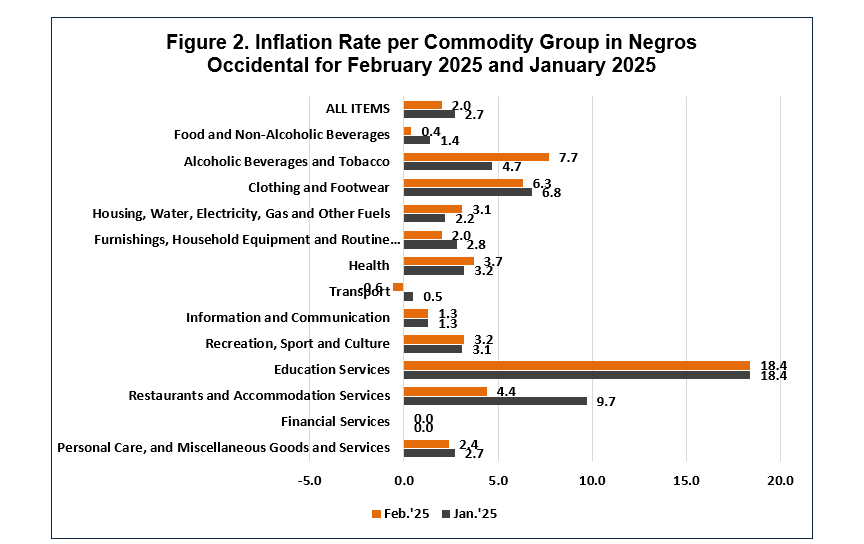
Source: Philippine Statistics Authority
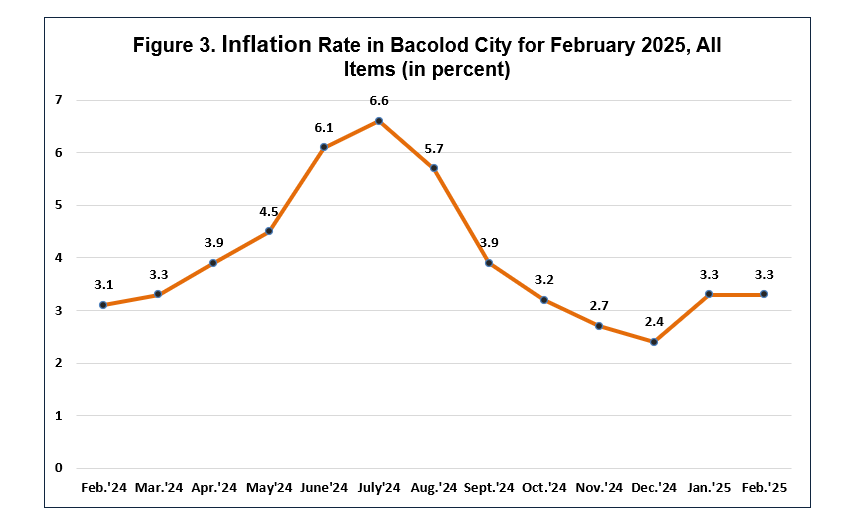 Source: Philippine Statistics Authority
Source: Philippine Statistics Authority
In Bacolod City, the Inflation Rate for All Income Households remains at its previous month’s rate of 3.3 percent and increased against last year February 2024 at 3.1 percent. (See Figure 3.). The rise up in the year-on-year inflation rate was attributed by a positive indices in some commodities like; Alcoholic Beverages & Tobacco at 5.0 percent from 4.4 percent, Housing/Water/Electricity/Gas and Other Fuels at 1.5 percent from 0.1 percent, health at 4.9 percent from 4.5 percent, and Restaurants & Accommodation Services at 8.1 percent from 7.6 percent.
Relative to their annual rates, lower inflation rate were observed for Clothing and Footwear at
6.8 percent from 9.4 percent, Furnishings, Household Equipment and Routine Household Maintenance at 2.3 percent from 3.0 percent, Transport at -1.1 percent from 0.7 percent, Information and Communication at 0.4 percent from 1.1 percent, and Recreation/Sports & Culture at 4.8 percent from 5.4 percent, in February 2025.
The indices of the rest of the commodities retained their previous months annual growth rates. (See Figure 4)
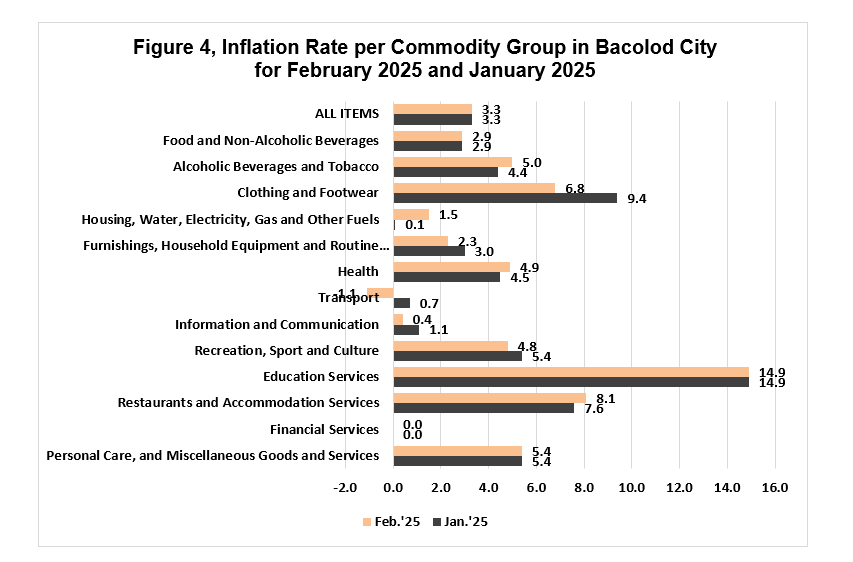
Source: Philippine Statistics Authority
Food & Non-Alcoholic Beverages inflation, in Negros Occidental’s monthly decreases in the seasonally adjusted CPI for February 2025 resulted to a decline in inflation at 0.4 percent from 1.4 percent in January 2025 and against January 2024 at 3.7 percent. Bacolod City remains at its previous food inflation rate at 2.9 percent and decline against last year of the same month with 3.8 percent.

Source: Philippine Statistics Authority
Negros Occidental’s Annual growth rate for the seasonally adjusted Consumer price Index (CPI) for February 2025, exhibited a decrease in some food commodities like; Cereals & Cereals Products at -3.3 percent from 0.8 percent in February 2025, Rice at -4.5 percent from 0.5 percent, Flour, Bread and Other Bakery Products, Pasta Products and Other Cereals at 0.5 percent from 1.1 percent, Milk, Other Dairy Products and Eggs at 6.0 percent from 7.6 percent, Fruits & Nuts at 0.2 percent from 1.9 percent, Ready-Made Food and Other Food Products N.E.C. at 2.2 percent from 2.8 percent, and Non- Alcoholic Beverages at 3.6 percent from 4.4 percent.
Annual rates of increases were recorded in the following food commodities like: Cereals (Corn) at 3.1 percent from 5.9 percent, Meat and Other Parts of Slaughtered Land Animals at 4.7 percent from 3.0 percent, Fish and Other Seafoods at -2.2 percent from -3.9 percent, Oils and Fats at -3.5 percent from -3.6 percent, and Vegetables, Tubers, Cooking Bananas and Pulses at 6.0 percent from 3.9 percent. (See Table 3)
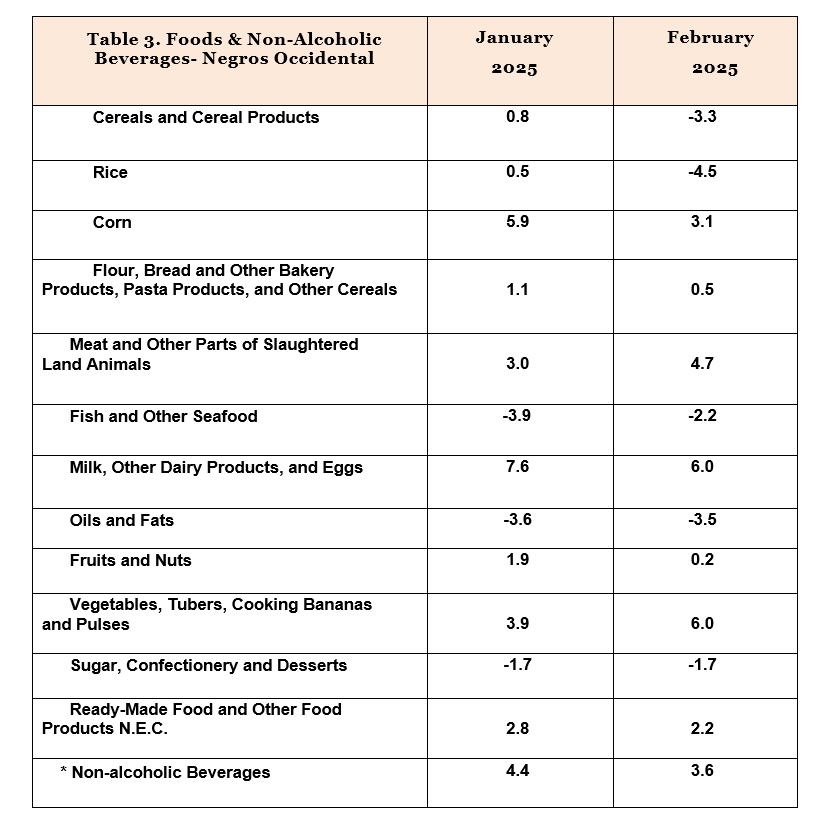
Source: Philippine Statistics Authority
In Bacolod City, year-on-year inflation maintains its previous months rate of 2.9 percent for Food & Non-Alcoholic Beverages for the month of February 2025 despite the rise up of some commodities on the year-on- year inflation rate like; Meat and Other Parts of Slaughtered Land Animals at 5.8 percent from 3.9 percent, Oils & Fats at -3.6 percent from -5.2 percent, Fruits & Nuts at -4.0 percent from -4.5 percent, Sugar/Confectionery & Desserts at -1.7 percent from -2.4 percent, and Non-Alcoholic Beverages at 5.9 percent form 4.7 percent.
Annual growth rates showed a decrease on the following commodities: Cereals and Cereals Products at 1.6 percent from 1.9 percent, Cereals (Rice) at 1.5 percent from 2.1 percent, Corn at 3.0 percent from 3.3 percent, Fish and Other Seafoods at 3.0 percent from 3.3 percent, Milk/Other Dairy Products and Eggs at 5.0 percent from 5.6 percent, Vegetables/Tubers/Cooking Bananas and Pulses at 5.3 percent from 7.4 percent, and Ready-Made Food and Other Food Products N.E.C. at 3.0 percent from 3.9 percent. The indices of the rest of the food commodity groups still retain their annual growth rates from the previous month. (See Table 4)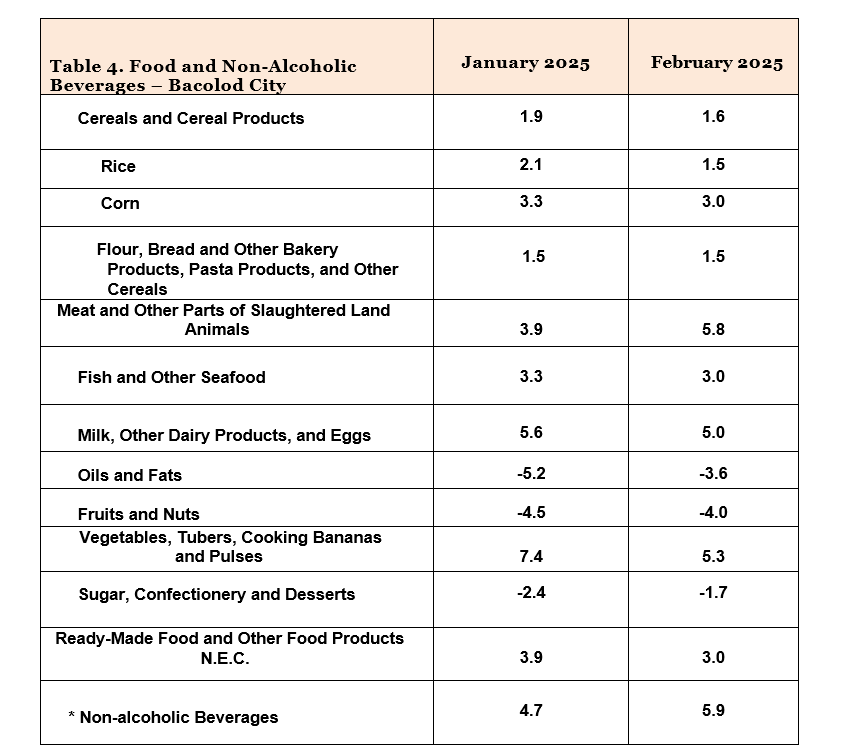
Source: Philippine Statistics Authority
Non-Food Inflation for February 2025, Negros Occidental slightly decline to 3.1 percent from 3.8 percent in January 2025. The decrease was due to the decline in Clothing & Footwear, Furnishing/Household Equipment and Maintenance, Transport, Restaurant and Accommodation Services, and Personal Care and Miscellaneous Goods and Services. Bacolod City, posted a slight increase at 3.5 percent from 3.4 percent in January 2025 this were due to the annual year-on-year upward trend in the indices of some commodities like; Housing/Water//Electricity/Gas and Other Fuels, Health, and Restaurant and Accommodation Services, Financial Services. (See Table 5)

Source: Philippine Statistics Authority
Table 2. Year-on-Year Inflation Rates of the CPI for All Income Households in Negros Occidental and Bacolod City, January 2022 to January 2025.

Source: Philippine Statistics Authority

